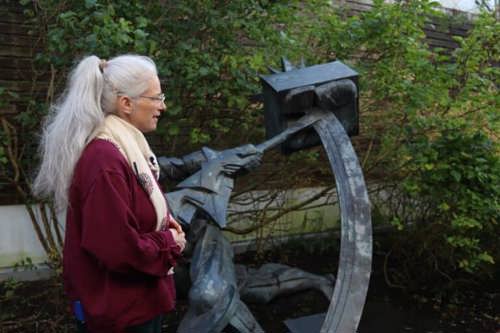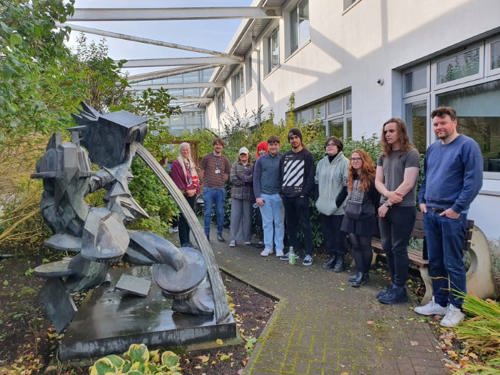 The College was delighted to welcome back Stephanie de Roemer, Conservator with Glasgow Life Museums, to the East End Campus in October. The powerful sculpture, ‘A Mighty Blow For Freedom’ by renowned sculptor Michael Sandle, is a focal point in the campus Sensory Garden area and has been ‘on loan’ to the College for 15 years from Glasgow Life, the charity responsible for culture and sport in the city.
The College was delighted to welcome back Stephanie de Roemer, Conservator with Glasgow Life Museums, to the East End Campus in October. The powerful sculpture, ‘A Mighty Blow For Freedom’ by renowned sculptor Michael Sandle, is a focal point in the campus Sensory Garden area and has been ‘on loan’ to the College for 15 years from Glasgow Life, the charity responsible for culture and sport in the city.
As conservator, Stephanie has been undertaking 3-yearly visits to ensure that the piece remains in good condition, and this year her discussions with Mary Connelly in Estates were a springboard for a unique learning experience with our students across a range of subjects.
Engaging with students and staff from Biology & Chemistry, as well as those from Art & Design, Stephanie talked expertly about how the sculpture was made, what it means, the artist and his work and also the practices and aims of conservation.
Stephanie’s talks were highly engaging and inspirational and a few of the students are now keen to pursue Conservation as a career option.
She was good enough to share some of her thoughts and experience with us for the newsletter. She writes:
“I have been visiting the sculpture ‘A blow for freedom’, by British artist and sculptor Michael Sandle, since 2007 every three years, to check its condition and wellbeing in situ in the sensory garden of the college. The sculpture belongs to the collections of the Glasgow Museums and is on a long term loan to the college. I work for Glasgow Life Museums as a conservator for Sculpture and Installation art, I often describe what I do as being ‘a doctor for objects’. My role is to look after the sculptures in Glasgow Museums Collections alongside my conservation colleagues for textiles, transport and technology, natural history, paintings, works on paper, frames, furniture and Historic Art Decorative objects.
We maintain and carry out the technical and practical care of the many objects belonging to the collection, while we also advise on transport, handling and installation of objects.
The current location for the sculpture is the first public display since Glasgow Museums acquired the work in 1991, yet, it is fairly hidden from view and perception of most visitors, students, lecturers and personnel of the college.
As a bronze the sculpture has been fabricated in what is considered a permanent media – bronze- and has always been intended to be shown in prominent public spaces and places including the outdoors.
Over the last 15 years since the sculpture has arrived in the sensory garden its condition has changed, predominantly in terms of its surface colouration, texture and homogeneity. The surface patination applied shortly after the sculpture was cast in the Tallix Morris Singer Foundry, a mix of chemicals and wax were applied to provide a protective and homogenous surface patination, that would serve to protect the bronze from rapid corrosion in an environment such as the outdoors at the West Coast of Scotland!
The surface appearance of the sculpture is now much paler, a greyish base tone with localised cream-coloured marks and tones of blue and green indicate the surface weathering and an overall change of its colouration.
As part of my responsibility as the conservator for this sculpture, I have to report back to the museums team on what the condition is and also what my recommendations are for the sculpture’s care and maintenance for the future (this is a long-term loan with no end date at present).
I was keen to hear from those who house the sculpture, who sees it, or who haven’t yet even noticed its presence, what they thought of it. Do they relate to it? Do they find it intriguing? Having had the opportunity to provide access to the artwork, by explaining how it was made, what the thinking behind it and its controversial title is, interesting discussions and questions arose from the many students of the varying training courses. I personally and professionally have learned much from the week’s encounters with students, lecturers and those who maintain and look after the building and feel that the artwork has provided an opportunity for further collaboration between lender (Glasgow Museums) and borrower (Glasgow Kelvin College) and engagement with conservation, sculpture and art.
It is hopefully just the beginning towards future care, maintenance and accessibility to the sculpture as a joint endeavour and mutual relationship between the college and Glasgow Life Museums with the sculpture as an advocate for conservation – the care for our shared cultural heritage.
Thank you to all for listening and participating!”
 And thank you from the College, Steph, for taking the time to introduce our students to the fascinating world of conservation and firing their interest in the discipline. We look forward to welcoming you back in three years when a whole new cohort of students can benefit from your knowledge and experience.
And thank you from the College, Steph, for taking the time to introduce our students to the fascinating world of conservation and firing their interest in the discipline. We look forward to welcoming you back in three years when a whole new cohort of students can benefit from your knowledge and experience.
In the meantime, this project has been a prime example of how partnerships can enhance the student experience and we’re keen to see how best Glasgow Kelvin and Glasgow Life Museums can work together to benefit our learners in the future!

